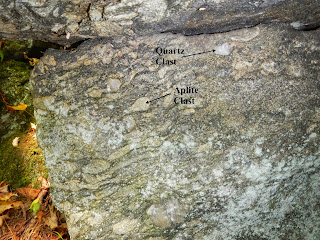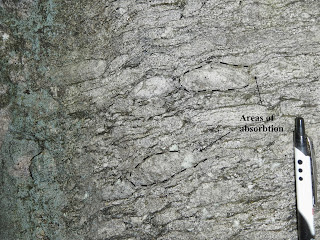Stop 2.1 - Stamford Granite Gneiss (SGG) at the power lines
This rock has large feldspar crystals (both plagioclase and potassium feldspar) that can be easily identified by the sun glinting off of their cleavage planes. The SGG is an example of a rapakivi granite, which is a form of granite that contains large K-spar crystals with plagioclase rims. The SGG also contains biotite, muscovite, and blue-ish quartz that projects out of the rock face due to its resistance to weathering (Fig 2.1). The rock is weakly foliated (Fig. 2.2), and contains younger quartz veins that are undeformed. The SGG was intruded 960-980 Ma, after the Mesoproterozoic Grenville Orogeny.
 |
Figure 2.1. Quartz nodules that project from the weathered surface.
The quartz is more resistant to weathering than the surrounding feldspar |
 |
| Figure 2.2. Weak foliation, outlined by red dashed line. |
Stop 2.2 - Stamford Granite Gneiss at Lost Pond
Here, the SGG has a smaller grain size, stronger foliation (Fig 2.3) with thinner layers, and is essentially a more deformed version of the rock at the power lines. There are a couple ways of interpreting the higher level of deformation here. It is possible that this area was more weathered before deformation occured, and was therefore more susceptible to deformation. The second option has to do with the location's proximity to the unconformity with the Dalton conglomerate. The conglomerate has experienced strong deformation, so while the center of the pluton would have a uniformly low level of deformation, the outer edge could have experienced some shear stress because it was next to highly ductile sedimentary rocks.
 |
| Figure 2.3. Thinner and more defined foliation outlined by dashed red lines. |
Stop 2.3 - First Conglomerate Outcrop (Dalton Formation)
Sedimentary rock with quartz and aplite (a finely grained granitic composition, forms at late stage of pluton cooling) clasts (Fig. 2.4), sometimes in pebble layers that stand out from the matrix. Some of the quartz pebbles are rounded, not squeezed and deformed. However, the aplite rock fragments that are very squashed. These aplite fragments are being reabsorbed into the matrix (Fig. 2.5), which is also made of granitic minerals.
 |
| Figure 2.4. Notice the quartz and aplite clasts. |
 |
| Figure 2.5. Deformation of the aplite clasts (outlined by dashed black lines), and their partial absorption into the matrix. |
Stop 2.4 - Second Conglomerate Outcrop (Dalton Formation)
Here the clasts are more deformed, even some of the quartz clasts are a bit flattened and strained. Alternating zones of clast-rich and matrix-rich rock (Fig. 2.6) may be an indication of original bedding.
 |
| Figure 2.6. Alternating zones, separated by dashed black lines |
Arkose Sandstone
Further north, we see outcrops with interbedding of arkose sandstone and the conglomerate from stops 3.3 and 3.4, with the arkose having a more quartz-rich matrix. As you move farther north, the conglomerate begins to disappear completely.
Hoosac Schist
Eventually the sandstone gives way to Hoosac Schist. The schist is age equivalent to Cheshire quartzite, so we can assume that it was originally deposited in deeper coastal waters. It contains sizable garnets, some 3-4 mm across.
Summary
This trip
starts out in the clastics (conglomerates) associated with the rifting period of
Rodinia and igneous intrusions that are a part of the basement
(Stamford Granite Gneiss) As Rodinia broke apart apart, sediments accumulated in the basins that formed on the slope-rise of the continent (Fig. 2.7). The differentiation of conglomerates and sandstone probably have to do with fluvial transportation potential going into the basins. We eventually moved into
other sedimentary rocks that must have been deposited in much deeper waters
(Hoosac Garnet Schist).
 |
| Figure 2.7. Diagram shows the basins that form during the rifting period of continental breakup. From Allen et al. 2010. |







No comments:
Post a Comment